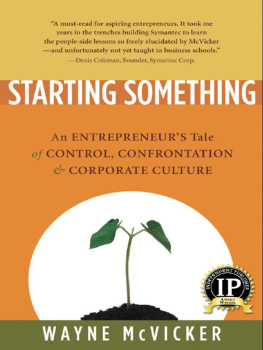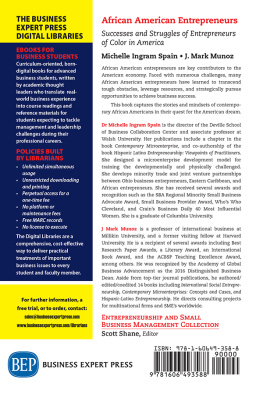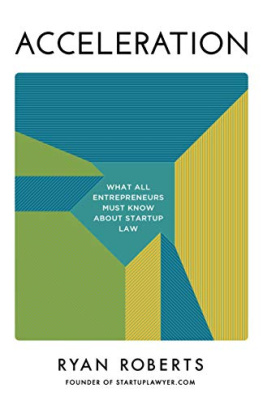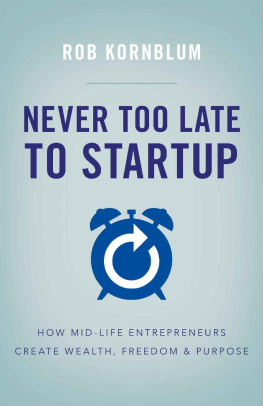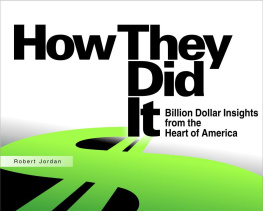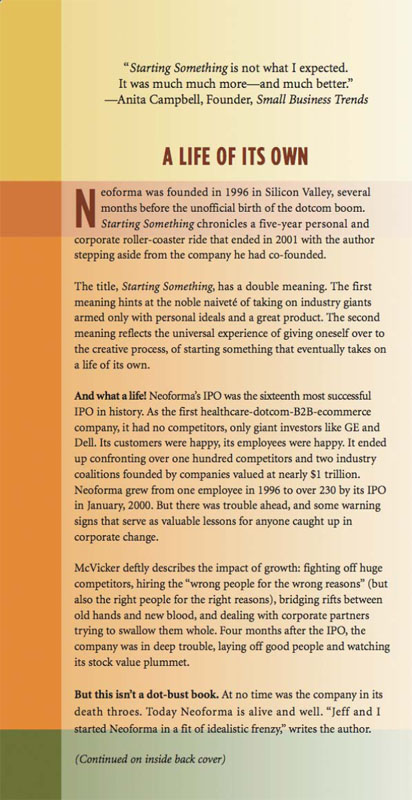STARTING SOMETHING
An ENTREPRENEURS Tale
of CONTROL, CONFRONTATION
& CORPORATE CULTURE
Wayne McVicker
Starting Something: An Entrepreneurs Tale of Control,
Confrontation & Corporate Culture
2005 by Wayne McVicker. All rights reserved.
No portion of this publication may be reproduced, stored in a retrieval system or transmitted in any form or by any means without the prior written permission of the author or publisher.
Published by Ravel Media
Ravel Media, LLC
www.ravel.tv
Printed in USA
Book design/typography by Sara Patton
Cover writing by Susan Kendrick Writing
ISBN-13: 978-1-932881-00-4
LCCN: 2004093746
Publishers Cataloging-in-Publication
(Provided by Quality Books, Inc.)
McVicker, Wayne.
Starting something : an entrepreneurs tale of control, confrontation & corporate culture / Wayne McVicker. p. cm.
Includes index.
ISBN 1-932881-02-6 (pbk.)
1. McVicker, Wayne. 2. Corporate cultureUnited States. 3. EntrepreneurshipUnited StatesCase studies. 4. Neoforma (Firm) 5. BusinessmenUnited StatesBiography. I. Title.
| HB615.M38 2004 | 658.421 |
| QBI33-2040 |
For Anni
| Introduction |  |
I made a few hundred million. I lost a few hundred million. But that does not in itself make this story particularly unique considering the place and time: Silicon Valley, at the end of the twentieth century.
Back in 1996, my partner, Jeff Kleck, and I started a company called Neoforma. We started with a product. A good and needed product. But this product served a very large and complex audience the healthcare industry. So we could only provide for its initial needs. Other people would be needed to facilitate its growth and ensure its survival. Our company had to grow into something beyond its product. As it happened, it turned into quite a large production.
This book is about control.
When we started Neoforma, Jeff and I were firmly in control. As we hired people and invited investors, we had to yield some of that control. Sometimes we gave too little. Sometimes we gave too much. Sometimes it didnt matter. Sometimes I wanted to scream.
This book is about confrontation.
Jeff and I knew that our ideas and product might stir things up a bit. In fact, we believed that the healthcare equipment industry could use quite a bit of stirring. So there was certainly some level of spunk and rebellion in us when we started Neoforma, but we really didnt mean to start a fight. We were young, but not that young. However, fights are what we got. One after another.
And this book is about corporate culture.
We had become frustrated with one companys culture. We left that company in a fit of rebellion and opportunity. When we had the chance to start from scratch, we were committed to building something creative and empowering something more like us. But a cultures formation is complex and subtle. Everyone who touches a company affects it. The earlier they touch it, the more they affect it. In the beginning, Jeff and I were the culture. In the end, the culture had little need for us.
In 1995, as I began to realize that I might soon be heading down the entrepreneurial path, I was fortunate to come across Jerry Kaplans book, Start-up . I read with great interest his story of the formation of a pen-computing company that would entrance, befriend and then be crushed by industry giants.
I was both entertained and educated by Kaplans book. Now that I have been on a similar journey, I believe there is more to say.
This book is not a guide on how to start a company, though it should certainly be helpful for anyone planning to start something. This is not a history book, though its context is quite historic. Instead, its a look at some of the peculiar ways that things get started. Some of this book is about business. Most of it is about how people individuals and groups of people interact with each other in new and unusual situations.
No complex series of events can be fully understood without some consideration of its context. The time and place in which this story took place distorted and magnified what might otherwise have been relatively mundane behavior. In the final years of the twentieth century, Silicon Valley was quite an unusual place. Everyone involved with a plethora of new businesses felt more important than they had ever expected to feel. That alone led to some interesting situations.
Any assumption that this story accurately reflects historical truth should be weighed against the fact that I have a perverse tendency to feel certain in the absence of uncertainty and to feel skeptical in the presence of facts.
While the name of the company on which this story is based is factual, and can be verified, the events described in the following chapters should be assumed to be at least partially fictional being based primarily on the notes and memory of one person. In the interest of privacy and self-preservation, the names of most of the characters and some of the companies have been changed. For the most part, its not who did what that matters. Instead, its what they did and maybe why they did it that provokes thoughtful retrospection.
I must also mention that, regardless of my take on things, you should tacitly assume that the characters and events in this book all have equal and opposite sides. I, of course, only see what I saw.
| The Printer |  |
Somehow, I ended up on the outside, looking in.
An initial public stock offering (IPO) represents a companys official launch into the delightful realm of public scrutiny. It is the time when a company steps into the public limelight, drops its drawers, and says Look at me. Heres what I intend to offer you . To competitors, it is the first real glimpse at the companys pricing and positioning strategy. To investors, it is the first chance to evaluate whether this new offering represents a chance to make a killing.
As Neoformas IPO documents were being sketched out, I kept hearing talk about the Printer. I assumed that it was jargon for something I should already know about, so I just went along, nodding and smiling, without asking what it meant.
The Printer was actually a specially designed place where public companies massive reporting documents are assembled by large teams of people, then electronically submitted to the SEC. Several companies are usually involved in various filings at the Printer at any given time. Each is assigned conference rooms and given access to an assortment of food and beverages.
Almost twenty-four hours a day for weeks, an amazingly large group of young lawyers, accountants and investment bankers almost none of whom I knew had been enthusiastically gathering and assembling mounds of obscure Neoforma information into crowded conference rooms.

